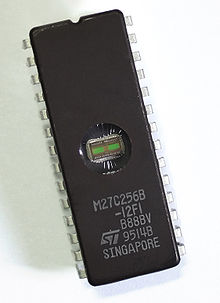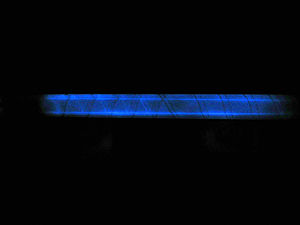- Fused quartz
-
 A sphere manufactured by NASA out of fused quartz for use in a gyroscope in the Gravity Probe B experiment. It is one of the most accurate spheres ever created by humans, differing in shape from a perfect sphere by no more than 40 atoms of thickness. It is thought that only neutron stars are smoother.
A sphere manufactured by NASA out of fused quartz for use in a gyroscope in the Gravity Probe B experiment. It is one of the most accurate spheres ever created by humans, differing in shape from a perfect sphere by no more than 40 atoms of thickness. It is thought that only neutron stars are smoother.
Fused quartz and fused silica are types of glass containing primarily silica in amorphous (non-crystalline) form. They are manufactured using several different processes. Note that glasses formed by the traditional 'melt–quench' methods (heating the material to melting temperatures, then rapidly cooling to the solid glass phase), are often referred to as 'vitreous', as in 'vitreous silica'. The term 'vitreous' is synonymous with 'glass', when used in the melt–quench context.
Fused quartz is manufactured by melting naturally occurring quartz crystals of high purity at approximately 2000 °C, using either an electrically heated furnace (electrically fused) or a gas/oxygen-fuelled furnace (flame fused). Fused quartz is normally transparent. The optical and thermal properties of fused quartz are superior to those of other types of glass due to its purity. For these reasons, it finds use in situations such as semiconductor fabrication and laboratory equipment. It has better ultraviolet transmission than most other glasses, and so is used to make lenses and other optics for the ultraviolet spectrum. Its low coefficient of thermal expansion also makes it a useful material for precision mirror substrates.
Fused quartz can also form naturally. The naturally occurring form is a metamorphic rock known as quartzite. An increase in pressure and temperature causes the quartz crystals within the rock to fuse together. An important distinction is that the quartz in quartzite is not an amorphous form.
Fused silica is produced using high-purity silica sand as the feedstock, and is normally melted using an electric furnace, resulting in a material that is translucent or opaque. (This opacity is caused by very small air bubbles trapped within the material.)
Synthetic fused silica is made from a silicon-rich chemical precursor usually using a continuous flame hydrolysis process which involves chemical gasification of silicon, oxidation of this gas to silicon dioxide, and thermal fusion of the resulting dust (although there are alternative processes). This results in a transparent glass with an ultra-high purity and improved optical transmission in the deep ultraviolet. One common method involves adding silicon tetrachloride to a hydrogen–oxygen flame, however use of this precursor results in environmentally unfriendly by-products including chlorine and hydrochloric acid. To eliminate these by-products, new processes have been developed using an alternative feedstock, which has also resulted in a higher purity fused silica with further improved deep ultraviolet transmission.
Fumed silica is manufactured by a similar flame hydrolysis process to synthetic fused silica, however it is in the form of a fine powder/dust and is typically used in applications such as fillers for rubbers and plastics, coatings, adhesives, cements, sealants, cosmetics, pharmaceuticals, inks and abrasives.
Contents
Chemistry
Fused quartz is a noncrystalline form of silicon dioxide (SiO2), which is also called silica. (The crystalline form of this material is quartz). Though quartz glass in theory contains only silicon and oxygen, industrially produced quartz glass / fused silica contains impurities. The typical impurities depend on the starting material and the process used. The most dominant impurities are aluminium and titanium.[1]
Quartz has a high melting point because many strong covalent bonds have to be broken.
Applications
Specially prepared fused silica is the key starting material used to make optical fiber for telecommunications.
Because of its strength and high melting point (compared to ordinary glass), fused silica is used as an envelope for halogen lamps, which must operate at a high envelope temperature to achieve their combination of high brightness and long life.
The combination of strength, thermal stability, and UV transparency makes it an excellent substrate for projection masks for photolithography.
 An EPROM with fused quartz window in the top of the package
An EPROM with fused quartz window in the top of the package
Its UV transparency also finds uses in the semiconductor industry; an EPROM, or erasable programmable read only memory, is a type of memory chip that retains its data when its power supply is switched off, but which can be erased by exposure to strong ultraviolet light. EPROMs are recognizable by the transparent fused quartz window which sits on top of the package, through which the silicon chip is visible, and which permits exposure to UV light during erasing.
Due to the thermal stability and composition it is used in semiconductor fabrication furnaces.
Fused quartz has nearly ideal properties for fabricating first surface mirrors such as those used in telescopes. The material behaves in a predictable way and allows the optical fabricator to put a very smooth polish onto the surface and produce the desired figure with fewer testing iterations. In some instances, a high-purity UV grade of fused quartz has been used to make several of the individual uncoated lens elements of special purpose lenses including the Zeiss 105mm f/4.3 UV Sonnar, a lens formerly made for the Hasselblad camera, and the Nikon UV-Nikkor 105mm f/4.5 (presently sold as the Nikon PF10545MF-UV) lens. These lenses are used for UV photography, as the quartz glass has a lower extinction rate than lens made with more common flint or crown glass formulas.
Fused silica as an industrial raw material is used to make various refractory shapes such as crucibles, trays, shrouds, and rollers for many high-temperature thermal processes including steelmaking, investment casting, and glass manufacture. Refractory shapes made from fused silica have excellent thermal shock resistance and are chemically inert to most elements and compounds including virtually all acids, regardless of concentration, except hydrofluoric acid which is very reactive even in fairly low concentrations. Translucent fused silica tubes are commonly used to sheathe electric elements in room heaters, industrial furnaces and other similar applications.
Thanks to its low mechanical damping at ordinary temperatures, it is used for high-Q resonators, in particular, for wine-glass resonator of hemispherical resonator gyro (HRG).[2][3]
Quartz glassware is occasionally used in chemistry laboratories when standard borosillicate glass can not withstand high temperatures; it is more commonly found as a very basic element, such as a tube in a furnace, or as a flask, the elements in direct exposure to the heat.
Physical properties
The extremely low coefficient of thermal expansion, about 5.5×10−7/°C (20–320 °C), accounts for its remarkable ability to undergo large, rapid temperature changes without cracking (see thermal shock).
Fused quartz is prone to phosphorescence and "solarisation" (purplish discoloration) under intense UV illumination, as is often seen in flashtubes. "UV grade" synthetic fused silica (sold under various tradenames including "HPFS", "Spectrosil" and "Suprasil") has a very low metallic impurity content making it transparent deeper into the ultraviolet. An optic with a thickness of 1 cm will have a transmittance of about 50% at a wavelength of 170 nm, which drops to only a few percent at 160 nm. However, its infrared transmission is limited by strong water absorptions at 2.2 μm and 2.7 μm.
"Infrared grade" fused quartz (tradenames "Infrasil", "Vitreosil IR" and others) which is electrically fused, has a greater presence of metallic impurities, limiting its UV transmittance wavelength to around 250 nm, but a much lower water content, leading to excellent infrared transmission up to 3.6 μm wavelength. All grades of transparent fused quartz/fused silica have nearly identical physical properties.
The water content (and therefore infrared transmission of fused quartz and fused silica) is determined by the manufacturing process. Flame fused material always has a higher water content due to the combination of the hydrocarbons and oxygen fuelling the furnace forming hydroxyl [OH] groups within the material. An IR grade material typically has an [OH] content of <10 parts per million.
Typical properties of clear fused silica
- Density: 2.203 g/cm3
- Hardness: 5.3–6.5 (Mohs scale) , 8.8 GPa
- Tensile strength: 48.3 MPa
- Compressive strength: >1.1 GPa
- Bulk modulus: ~37 GPa
- Rigidity modulus: 31 GPa
- Young's modulus: 71.7 GPa
- Poisson's ratio: 0.17
- Lame elastic constants: λ=15.872 GPa, μ=31.261 GPa
- Coefficient of thermal expansion: 5.5×10−7/°C (average from 20 °C to 320 °C)
- Thermal conductivity: 1.3 W/(m·K)
- Specific heat capacity: 45.3 J/(mol·K)
- Softening point: c. 1665 °C
- Annealing point: c. 1140 °C
- Strain point: 1070 °C
- Electrical resistivity: >1018 Ω·m
- Dielectric constant: 3.75 at 20 °C 1 MHz
- Dielectric loss factor: less than 0.0004 at 20 °C 1 MHz
- Index of refraction: at 587.6 nm (nd): 1.4585
- Change of refractive index with temperature (0 to 700 °C): 1.28×10−5/°C (between 20 and 30 °C)[4]
- Strain-optic coefficients: p11=0.113, p12=0.252.
- Hamaker constant: A=6.5 zJ.
- Dielectric strength: 250–400 kV/cm at 20 °C[5]
See also
References
- ^ Chemical purity of fused quartz / fused silica, www.heraeus-quarzglas.com
- ^ An Overview of MEMS Inertial Sensing Technology, February 1, 2003
- ^ Penn, Steven D.; Harry, Gregory M.; Gretarsson, Andri M.; Kittelberger, Scott E.; Saulson, Peter R.; Schiller, John J.; Smith, Joshua R.; Swords, Sol O. (2001). "High quality factor measured in fused silica". Review of Scientific Instruments 72 (9): 3670. doi:10.1063/1.1394183.
- ^ Malitson, I. H. (1965). "Interspecimen Comparison of the Refractive Index of Fused Silica". Journal of the Optical Society of America 55 (10): 1205. doi:10.1364/JOSA.55.001205.
- ^ Fused silica datapage
External Links
- "Frozen Eye to Bring New Worlds into View" Popular Mechanics, June 1931 General Electrics, West Lynn Massachusetts Labs work on large fuzed quartz blocks
Glass science topics Basics Glass formulation - AgInSbTe
- Bioglass
- Borophosphosilicate glass
- Borosilicate glass
- Ceramic glaze
- Chalcogenide glass
- Cobalt glass
- Cranberry glass
- Crown glass
- Flint glass
- Fluorosilicate glass
- Fused quartz
- GeSbTe
- Gold ruby glass
- Lead glass
- Milk glass
- Phosphosilicate glass
- Photochromic lens glass
- Silicate glass
- Soda-lime glass
- Sodium hexametaphosphate
- Soluble glass
- Tellurite glass
- Ultra low expansion glass
- Uranium glass
- Vitreous enamel
- Wood's glass
- ZBLAN
Glass-ceramics Glass preparation Optics - Achromat
- Dispersion
- Gradient index optics
- Hydrogen darkening
- Optical amplifier
- Optical fiber
- Optical lens design
- Photochromic lens
- Photosensitive glass
- Refraction
- Transparent materials
Surface modification Diverse topics Categories:- Glass types
- Low-expansion glass
- Chemical engineering
- Glass compositions
- Silicon dioxide
- Transparent materials
- Quartz varieties
Wikimedia Foundation. 2010.

